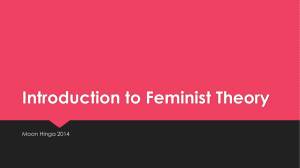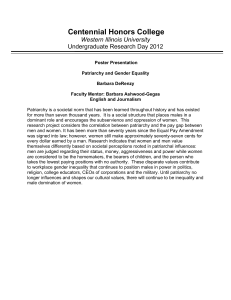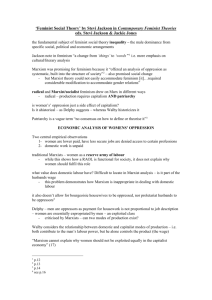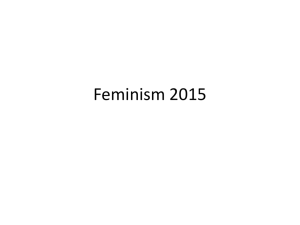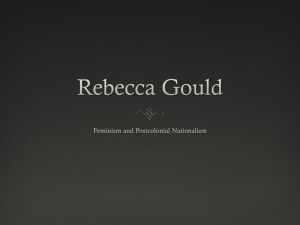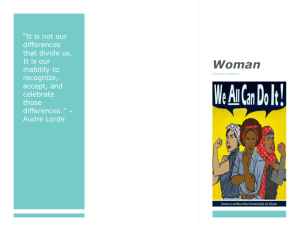Document 13466504
advertisement
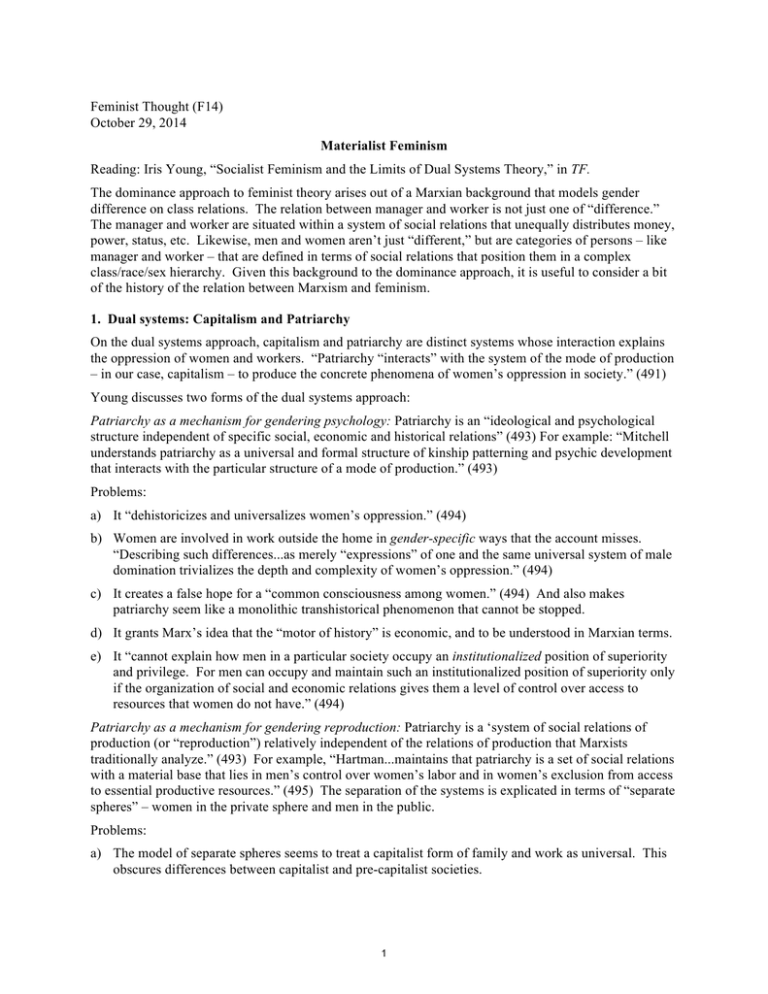
Feminist Thought (F14) October 29, 2014 Materialist Feminism Reading: Iris Young, “Socialist Feminism and the Limits of Dual Systems Theory,” in TF. The dominance approach to feminist theory arises out of a Marxian background that models gender difference on class relations. The relation between manager and worker is not just one of “difference.” The manager and worker are situated within a system of social relations that unequally distributes money, power, status, etc. Likewise, men and women aren’t just “different,” but are categories of persons – like manager and worker – that are defined in terms of social relations that position them in a complex class/race/sex hierarchy. Given this background to the dominance approach, it is useful to consider a bit of the history of the relation between Marxism and feminism. 1. Dual systems: Capitalism and Patriarchy On the dual systems approach, capitalism and patriarchy are distinct systems whose interaction explains the oppression of women and workers. “Patriarchy “interacts” with the system of the mode of production – in our case, capitalism – to produce the concrete phenomena of women’s oppression in society.” (491) Young discusses two forms of the dual systems approach: Patriarchy as a mechanism for gendering psychology: Patriarchy is an “ideological and psychological structure independent of specific social, economic and historical relations” (493) For example: “Mitchell understands patriarchy as a universal and formal structure of kinship patterning and psychic development that interacts with the particular structure of a mode of production.” (493) Problems: a) It “dehistoricizes and universalizes women’s oppression.” (494) b) Women are involved in work outside the home in gender-specific ways that the account misses. “Describing such differences...as merely “expressions” of one and the same universal system of male domination trivializes the depth and complexity of women’s oppression.” (494) c) It creates a false hope for a “common consciousness among women.” (494) And also makes patriarchy seem like a monolithic transhistorical phenomenon that cannot be stopped. d) It grants Marx’s idea that the “motor of history” is economic, and to be understood in Marxian terms. e) It “cannot explain how men in a particular society occupy an institutionalized position of superiority and privilege. For men can occupy and maintain such an institutionalized position of superiority only if the organization of social and economic relations gives them a level of control over access to resources that women do not have.” (494) Patriarchy as a mechanism for gendering reproduction: Patriarchy is a ‘system of social relations of production (or “reproduction”) relatively independent of the relations of production that Marxists traditionally analyze.” (493) For example, “Hartman...maintains that patriarchy is a set of social relations with a material base that lies in men’s control over women’s labor and in women’s exclusion from access to essential productive resources.” (495) The separation of the systems is explicated in terms of “separate spheres” – women in the private sphere and men in the public. Problems: a) The model of separate spheres seems to treat a capitalist form of family and work as universal. This obscures differences between capitalist and pre-capitalist societies. 1 b) Capitalism infiltrates the private sphere. It controls the “private work of consumption” and “rationalize[s] sexual and affective relations for its own ends” (496) c) Focusing on the private sphere of women’s labor “diverts attention from a capitalism that increasingly exploits women in gender-specific paid work.” (496) Conclusion: “It would be much more direct to construct a theory of capitalist patriarchy as a unified system entailing specific forms of gender structuring in its production relations and ideology.” We need not merely a synthesis of feminism with traditional Marxism, but also a thoroughly feminist historical materialism, which regards the social relations of a particular historical social formation as one system in which gender differentiation is a core attribute. (497 – italics in original). 2. Socialist Feminism as a Unified Theory Socialist feminism involves a commitment to “the practical unity of the struggle against capitalism and the struggle for women’s liberation.” (497) In Marx, historical materialism is the view that the “moving force” of history consists in changes in the material conditions caused by the need to produce and reproduce what’s needed for survival. In order to be productive, humans organize themselves into social relations that situate them differently with respect to the material goods and means of production that create consumable goods. Young argues that a “feminist historical materialism” must have several features: a) It must be a “total social theory.” (499) b) It must take seriously the idea that class and sex domination are intimately connected. c) It must be truly materialist. On her view, ...a materialist account [is] one that considers phenomena of “consciousness”...as rooted in real social relationships. This should not imply “reducing” such phenomena of consciousness to social structures and social relationships, nor does it even mean that the phenomena of consciousness cannot be treated as having a logic of their own. Nor should it mean that phenomena like attitudes and cultural definitions cannot enter as elements into the explanation of a particular structure of social relationships, though I would claim they can never be the sole explanation. This requirement calls for a methodological priority to concrete social institutions and practices, along with the material conditions in which they take place. (499) d) It must be thoroughly historical. “It must eschew any explanations that claim to apply to societies across epochs.” (499) Questions: 1. What are the social relations that constitute gender? (At least around here?) a. How are those social relations produced and reproduced? b. How is capitalism implicated? c. How do we account for intersectionality on this view? 2. How does understanding gender in terms of social relations fit with a dominance approach? 3. What are the strengths and weakness of this approach to gender? 4. What are the strengths and weakness of a historical materialist approach, understood in Young’s terms, generally. Young, Iris M. "Socialist Feminism and the Limits of Dual Systems Theory." In Theorizing Feminisms: A Reader. Edited by Elizabeth Hackett and Sally Haslanger. Oxford University Press, 2005. © Oxford University Press. All rights reserved. This content is excluded from our Creative Commons license. For more information, see http://ocw.mit.edu/help/faq-fair-use/. 2 MIT OpenCourseWare http://ocw.mit.edu WGS.301J / 17.007J / 24.237J / 17.006 Feminist Thought Fall 2014 For information about citing these materials or our Terms of Use, visit: http://ocw.mit.edu/terms.
